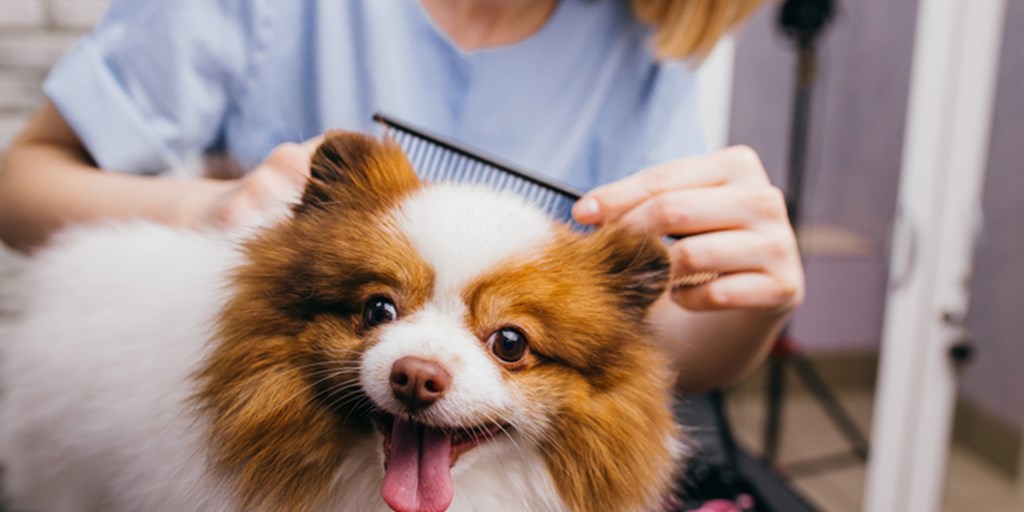Keeping your best friend clean can be a lot of work! Some dogs love to roll around in the mud or dig their clean little paws into the dirty garden looking for a bone buried there a week before. As adorable as it may be to watch your sweet little guy splash in puddles or happily romp around in the dirt, it also means you have some cleaning up to do!
Grooming your dog doesn’t need to be an intimidating experience. You should consider whether you’d prefer to take her to a groomer or clean her yourself. Lots of local pet stores offer grooming services and most veterinarians will clip your dog’s nails as a courtesy during a visit.
There are a couple options if you choose to go DIY. Of course, depending on your dog’s size, bathing at home can happen in the kitchen sink, laundry tub, bathtub or shower. Even if you decide to have your dog groomed by an expert, it’s helpful to keep some dog shampoo and conditioner in the house for that occasional spur of the moment bath after puppy zoomies through the mud! Another option to consider is a “Dog wash” where you can rent a self-serve wash station with goodies like shampoo, conditioner, towels and a blow dryer. That can make bath time easier, especially if you don’t have the right sized shower or tub at home. Check with a dog wash near you, but typically all you need is your dog, a brush and a leash.
No matter where you choose to groom your pup, here are a few tips to remember.
Develop a Regular Brushing Routine
Dogs should be brushed gently every day to keep hair from matting and to remove debris. Keep grooming sessions short and praise your best friend for cooperating. The goal is for her to become familiar with the activity and understand that it’s part of a daily routine.
As every dog matures, the brushing frequency may change depending on her breed and hair or fur type. Short-coated dogs only need to be brushed every few weeks to loosen the hair a bit. Dogs with thick-coated fur should be brushed every few days.
Get Comfortable with Bath Time
The first time you bathe your puppy can be intimidating for both you and your dog. Before you give your furry friend her first bath, gently put her in the tub or sink a few times without water. Play with her there, and praise her with a few of her favorite Bil-Jac Treats so she develops positive feelings about the bath area. When it’s time to get your pup squeaky clean during her first bath, she’ll be more comfortable. This familiarity with help makes bath time more pleasurable for you both!
Clean Your Dog’s Ears Regularly
Cleaning your dog’s ears can be a challenge, especially if she is unwilling to cooperate. However, it’s an important practice to help avoid infection and build-up of bacteria and yeast that can cause hearing damage. Dogs should have their ears cleaned once a week with an epi-otic cleaner. There are a number of epi-otic brands on the market—ask your veterinarian to make a recommendation.
Practice Good Doggy Dental Hygiene
Just like children, puppies lose their “baby” teeth. And, just like children, puppies benefit greatly from good dental hygiene. Grab a good doggy toothpaste and toothbrush from the pet store and get started. When you start brushing your pup’s teeth at an early age, she will be more cooperative during brushing as an adult dog. In addition to brushing, chewing bones and chew toys can help decrease the amount of plaque buildup, keeping those adorable puppy smiles shiny and white.
Keep Up with Paw-dicures
Trimming your dog’s nails is one of the most important parts of the overall grooming process. Not only does it make the nails more attractive, but it also helps prevent them from breaking. Most veterinarians provide nail clipping, as do groomers. If you decide to cut your buddy’s nails yourself keep these tips in mind:
- Use only nail clippers specifically designed for puppies/dogs.
- Be careful not to cut the nails too short. This can cause your puppy a good deal of pain and result in bleeding that you will want to stop using something like styptic powder.
- Try to create a calm environment when you trim his nails. Speak quietly and consider using treats to reward your puppy for cooperating during the trimming process.
- Start slowly. The first time you trim your puppy’s nails can be very confusing for him. Start with short sessions where all you do is rub his legs and paws gently. This can get your puppy accustomed to having you groom around his feet.
Grooming Your Dog for a Furever Bond
,

